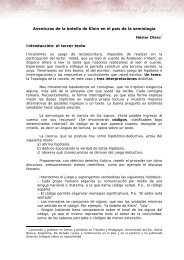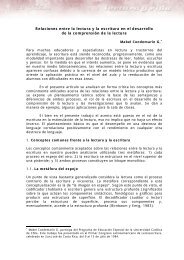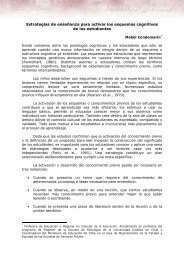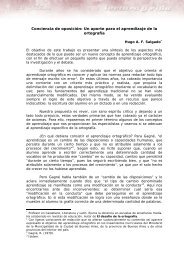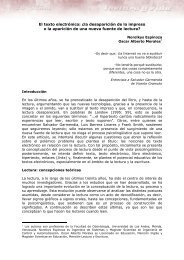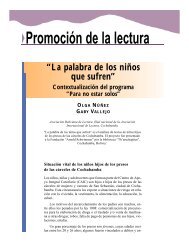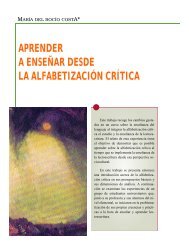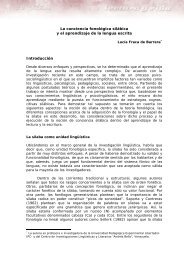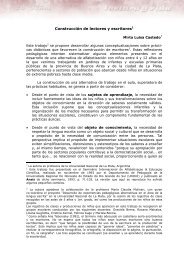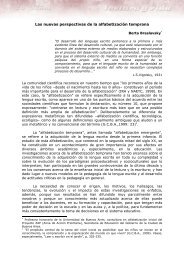influencia de la motiva ci ó ny el uso de estrategias ... - Lectura y Vida
influencia de la motiva ci ó ny el uso de estrategias ... - Lectura y Vida
influencia de la motiva ci ó ny el uso de estrategias ... - Lectura y Vida
You also want an ePaper? Increase the reach of your titles
YUMPU automatically turns print PDFs into web optimized ePapers that Google loves.
32<br />
LU LO HSUEH*<br />
INFLUENCIA DE LA MOTIVA C I Ó N<br />
Y EL USO DE ESTRATEGIAS EN<br />
LA COMPRENSIÓN LECTORA<br />
Este trabajo presenta una investiga<strong>ci</strong><strong>ó</strong>n<br />
acerca <strong>de</strong> <strong>la</strong> re<strong>la</strong><strong>ci</strong><strong>ó</strong>n que tienen <strong>la</strong><br />
<strong>motiva</strong><strong>ci</strong><strong>ó</strong>n y <strong>la</strong> con<strong>ci</strong>en<strong>ci</strong>a metacognitiva<br />
con <strong>la</strong> comprensi<strong>ó</strong>n lectora en alumnos<br />
que apren<strong>de</strong>n <strong>el</strong> español como segunda<br />
lengua en Taiwan. Se analizan<br />
aquí algunos aspectos <strong>de</strong> <strong>la</strong> <strong>motiva</strong><strong>ci</strong><strong>ó</strong>n y<br />
<strong>ci</strong>ertas <strong>estrategias</strong> <strong>de</strong> autocontrol y regu<strong>la</strong><strong>ci</strong><strong>ó</strong>n<br />
<strong>de</strong>l aprendizaje, en re<strong>la</strong><strong>ci</strong><strong>ó</strong>n con<br />
una tarea <strong>de</strong> lectura <strong>de</strong>terminada. Los resultados<br />
muestran <strong>la</strong> existen<strong>ci</strong>a <strong>de</strong> re<strong>la</strong><strong>ci</strong>ones<br />
entre estos factores, pero habilitan<br />
al mismo tiempo una interesante discusi<strong>ó</strong>n<br />
sobre <strong>el</strong> modo en que efectivamente<br />
in<strong>ci</strong><strong>de</strong>n en <strong>la</strong> comprensi<strong>ó</strong>n. Los profesores<br />
<strong>de</strong> lengua extranjera podrán consi<strong>de</strong>rar<br />
estos resultados para <strong>el</strong> diseño <strong>de</strong> <strong>estrategias</strong><br />
<strong>de</strong> enseñanza y <strong>de</strong> <strong>motiva</strong><strong>ci</strong><strong>ó</strong>n,<br />
así como para establecer los estilos <strong>de</strong><br />
lectura <strong>de</strong> sus alumnos y obtener así mejores<br />
resultados en <strong>la</strong> comprensi<strong>ó</strong>n lectora<br />
<strong>de</strong> textos en español.
Introduc<strong>ci</strong><strong>ó</strong>n<br />
Diversas posi<strong>ci</strong>ones te<strong>ó</strong>ricas e investiga<strong>ci</strong>ones<br />
re<strong>ci</strong>entes han seña<strong>la</strong>do <strong>la</strong> importan<strong>ci</strong>a <strong>de</strong> aten<strong>de</strong>r<br />
a los componentes cognitivos y metacognitivos<br />
implicados en <strong>el</strong> proceso <strong>de</strong>l aprendizaje<br />
<strong>de</strong> <strong>la</strong>s lenguas extranjeras (Bong, 1996; Astudillo<br />
y P<strong>el</strong>izza, 1999). En otros estudios, se reconoce<br />
<strong>la</strong> <strong>influen<strong>ci</strong>a</strong> <strong>de</strong> los componentes <strong>motiva</strong><strong>ci</strong>onales<br />
en <strong>el</strong> mismo proceso (Alonso Tapia,<br />
1995; García y Pintrich, 1996; Huertas, 1997;<br />
Braten y O<strong>la</strong>ussen, 1998; Lim<strong>ó</strong>n y Boquero,<br />
1999). En efecto, <strong>el</strong> aprendizaje se re<strong>la</strong><strong>ci</strong>ona<br />
con ambos aspectos: <strong>la</strong> <strong>motiva</strong><strong>ci</strong><strong>ó</strong>n y <strong>la</strong> con<strong>ci</strong>en<strong>ci</strong>a<br />
metacognitiva. La <strong>motiva</strong><strong>ci</strong><strong>ó</strong>n forma <strong>la</strong><br />
base <strong>de</strong> <strong>la</strong> conducta <strong>de</strong> los alumnos, los estimu<strong>la</strong><br />
para realizar <strong>la</strong>s tareas académicas y refleja <strong>la</strong><br />
responsabilidad que toman en su aprendizaje.<br />
En lo que se refiere a <strong>la</strong> metacogni<strong>ci</strong><strong>ó</strong>n, <strong>el</strong> <strong>uso</strong><br />
<strong>de</strong> <strong>estrategias</strong> <strong>de</strong> este tipo es <strong>de</strong> gran ayuda tanto<br />
para los alumnos que parti<strong>ci</strong>pan activamente<br />
en <strong>la</strong>s activida<strong>de</strong>s pedag<strong>ó</strong>gicas como para aqu<strong>el</strong>los<br />
que estudian con in<strong>de</strong>pen<strong>de</strong>n<strong>ci</strong>a, efica<strong>ci</strong>a y<br />
confianza. De esta perspectiva, este trabajo trata<br />
<strong>de</strong> investigar estos dos dominios y aspira a<br />
analizar <strong>la</strong>s posibles re<strong>la</strong><strong>ci</strong>ones entre <strong>el</strong> <strong>de</strong>sarrollo<br />
<strong>de</strong> <strong>la</strong> con<strong>ci</strong>en<strong>ci</strong>a matacognitiva y <strong>la</strong> <strong>motiva</strong><strong>ci</strong><strong>ó</strong>n<br />
<strong>de</strong> los alumnos, con <strong>el</strong> objetivo <strong>de</strong> conocer<br />
mejor <strong>el</strong> estilo <strong>de</strong> leer que emplean al estudiar<br />
español como lengua extranjera en Taiwán.<br />
Estudios previos<br />
Aspectos <strong>de</strong> <strong>la</strong> <strong>motiva</strong><strong>ci</strong><strong>ó</strong>n implicados<br />
en <strong>el</strong> aprendizaje<br />
La mayoría <strong>de</strong> los espe<strong>ci</strong>alistas coin<strong>ci</strong><strong>de</strong>n en <strong>de</strong>finir<br />
<strong>la</strong> <strong>motiva</strong><strong>ci</strong><strong>ó</strong>n como un conjunto <strong>de</strong> procesos<br />
implicados en <strong>la</strong> actividad, direc<strong>ci</strong><strong>ó</strong>n y persisten<strong>ci</strong>a<br />
<strong>de</strong> <strong>la</strong> conducta (McCl<strong>el</strong><strong>la</strong>nd, 1989;<br />
B<strong>el</strong>trán, 1993; Montico, 2004). Según Valenzue<strong>la</strong><br />
Gonzáles (1999), <strong>la</strong> <strong>motiva</strong><strong>ci</strong><strong>ó</strong>n es <strong>el</strong> conjunto<br />
<strong>de</strong> estados y procesos internos <strong>de</strong> <strong>la</strong> persona<br />
que <strong>de</strong>spiertan, dirigen y sostienen una actividad<br />
<strong>de</strong>terminada. Este concepto implica que<br />
un alumno <strong>motiva</strong>do: (1) convierte su interés<br />
por estudiar en ac<strong>ci</strong>ones concretas; (2) dirige<br />
sus estudios ha<strong>ci</strong>a metas <strong>de</strong>terminadas; y (3)<br />
sostiene sus estudios en una forma tal que con<br />
esfuerzo y persisten<strong>ci</strong>a alcanza <strong>la</strong>s metas.<br />
Aunque <strong>la</strong> literatura que trata <strong>de</strong> <strong>la</strong> <strong>motiva</strong><strong>ci</strong><strong>ó</strong>n<br />
ofrece una variedad <strong>de</strong> conceptos y teorías<br />
vincu<strong>la</strong>das con este tema, en nuestro trabajo solo<br />
re<strong>la</strong><strong>ci</strong>onamos <strong>la</strong> <strong>motiva</strong><strong>ci</strong><strong>ó</strong>n con los siguientes<br />
cuatro aspectos: a) creen<strong>ci</strong>as sobre <strong>la</strong> autoefica<strong>ci</strong>a;<br />
b) meta <strong>de</strong> orienta<strong>ci</strong><strong>ó</strong>n intrínseca; c) valora<strong>ci</strong><strong>ó</strong>n<br />
<strong>de</strong> <strong>la</strong> tarea y d) ansiedad.<br />
Creen<strong>ci</strong>as <strong>de</strong> autoefica<strong>ci</strong>a. Pintrich y García<br />
(1993) indican que <strong>la</strong>s creen<strong>ci</strong>as sobre <strong>la</strong> autoefica<strong>ci</strong>a<br />
en<strong>ci</strong>erran <strong>la</strong>s percep<strong>ci</strong>ones que tienen<br />
los alumnos sobre su capa<strong>ci</strong>dad para <strong>de</strong>sempeñar<br />
<strong>la</strong>s tareas requeridas en <strong>el</strong> curso. Huertas<br />
(1997) seña<strong>la</strong> que <strong>la</strong> i<strong>de</strong>a que tienen los alumnos<br />
sobre sus propias capa<strong>ci</strong>da<strong>de</strong>s influye en <strong>la</strong>s<br />
tareas que <strong>el</strong>igen, <strong>la</strong>s metas que se proponen, <strong>la</strong><br />
p<strong>la</strong>nifica<strong>ci</strong><strong>ó</strong>n, <strong>el</strong> esfuerzo y <strong>la</strong> persisten<strong>ci</strong>a <strong>de</strong><br />
<strong>la</strong>s ac<strong>ci</strong>ones encaminadas ha<strong>ci</strong>a esta meta.<br />
Meta <strong>de</strong> orienta<strong>ci</strong><strong>ó</strong>n intrínseca. Alonso Tapia<br />
(1995) sugiere que <strong>la</strong> <strong>motiva</strong><strong>ci</strong><strong>ó</strong>n parece in<strong>ci</strong>dir<br />
sobre <strong>la</strong> forma <strong>de</strong> pensar y, por tanto, sobre<br />
<strong>el</strong> aprendizaje. Así pues, <strong>el</strong> alumno <strong>motiva</strong>do sabe<br />
s<strong>el</strong>ec<strong>ci</strong>onar y realizar activida<strong>de</strong>s por <strong>el</strong> interés,<br />
curiosidad y <strong>de</strong>safío que estas le provocan<br />
personalmente. D<strong>el</strong> mismo modo, es posible<br />
también que <strong>el</strong> alumno esté más dispuesto a hacer<br />
un esfuerzo mental significativo durante <strong>la</strong><br />
realiza<strong>ci</strong><strong>ó</strong>n <strong>de</strong> <strong>la</strong> tarea y en <strong>el</strong> empleo <strong>de</strong> <strong>estrategias</strong><br />
para <strong>la</strong> comprensi<strong>ó</strong>n (Lepper, 1988).<br />
Valora<strong>ci</strong><strong>ó</strong>n <strong>de</strong> <strong>la</strong> tarea. Pintrich, Smith,<br />
García y Mckeachie (1989) argumentan que<br />
una valora<strong>ci</strong><strong>ó</strong>n positiva <strong>de</strong> <strong>la</strong>s tareas podría condu<strong>ci</strong>r<br />
al alumno a parti<strong>ci</strong>par más en <strong>el</strong> propio<br />
aprendizaje, y a utilizar <strong>estrategias</strong> con más frecuen<strong>ci</strong>a.<br />
Si <strong>la</strong>s tareas son per<strong>ci</strong>bidas como interesantes,<br />
importantes y útiles, <strong>el</strong> alumno podría<br />
estar más dispuesto a apren<strong>de</strong>r y obtener así<br />
mejores resultados.<br />
Ansiedad. Según Pintrich et al. (1989), este<br />
concepto se refiere al componente afectivo, pero<br />
esta vez re<strong>la</strong><strong>ci</strong>onado con pensamientos negativos.<br />
Postu<strong>la</strong>n que <strong>la</strong> ansiedad y <strong>la</strong> excesiva<br />
preocupa<strong>ci</strong><strong>ó</strong>n por <strong>el</strong> examen pue<strong>de</strong>n impedir <strong>el</strong><br />
<strong>uso</strong> <strong>de</strong> una estrategia y afectar también <strong>la</strong> confianza<br />
que <strong>el</strong> alumno tiene frente a <strong>la</strong> lectura.<br />
33
34<br />
Aspectos <strong>de</strong> <strong>la</strong>s <strong>estrategias</strong><br />
utilizadas en <strong>la</strong> lectura<br />
En cuanto a <strong>la</strong>s <strong>estrategias</strong> consi<strong>de</strong>radas<br />
en este trabajo, haremos<br />
referen<strong>ci</strong>a a <strong>la</strong>s <strong>de</strong> tipo cognitivo<br />
y metacognitivo. Las <strong>estrategias</strong><br />
cognitivas, en términos <strong>de</strong> Pintrich<br />
et al. (1989) y Pintrich y García<br />
(1993), incluyen pensamientos o comportamientos<br />
que ayudan a adquirir informa<strong>ci</strong><strong>ó</strong>n<br />
e integrar<strong>la</strong> al cono<strong>ci</strong>miento ya existente.<br />
En general, <strong>el</strong> cono<strong>ci</strong>miento previo es <strong>de</strong> amplio<br />
espectro y se c<strong>la</strong>sifica en varios tipos. Aquí nos<br />
referiremos al cono<strong>ci</strong>miento <strong>de</strong> tipo léxico,<br />
gramatical y <strong>de</strong> <strong>la</strong> estructura textual. Estos saberes<br />
fa<strong>ci</strong>litan <strong>la</strong> comprensi<strong>ó</strong>n <strong>de</strong> <strong>la</strong>s pa<strong>la</strong>bras<br />
<strong>de</strong>scono<strong>ci</strong>das, <strong>de</strong> <strong>la</strong>s frases difí<strong>ci</strong>les y <strong>de</strong> <strong>la</strong> organiza<strong>ci</strong><strong>ó</strong>n<br />
<strong>de</strong>l texto, lo que ayuda a los alumnos<br />
a distinguir <strong>la</strong>s i<strong>de</strong>as prin<strong>ci</strong>pales y subordinadas<br />
aso<strong>ci</strong>adas con <strong>el</strong> tema.<br />
Las <strong>estrategias</strong> metacognitivas tratan <strong>de</strong>l<br />
p<strong>la</strong>neamiento, control y regu<strong>la</strong><strong>ci</strong><strong>ó</strong>n <strong>de</strong>l proceso<br />
<strong>de</strong>l aprendizaje (Solé, 2003). El aspecto <strong>de</strong>l<br />
control se refiere a <strong>la</strong> capa<strong>ci</strong>dad <strong>de</strong>l alumno para<br />
evaluar lo que ha comprendido y cuestionarse<br />
a sí mismo durante <strong>la</strong> lectura, en tanto que <strong>la</strong><br />
regu<strong>la</strong><strong>ci</strong><strong>ó</strong>n <strong>de</strong>ja que <strong>el</strong> alumno ajuste <strong>la</strong>s ac<strong>ci</strong>ones<br />
cognitivas en fun<strong>ci</strong><strong>ó</strong>n <strong>de</strong>l control previo.<br />
Sin duda, todo <strong>el</strong>lo será benefi<strong>ci</strong>oso tanto para<br />
<strong>la</strong> comprensi<strong>ó</strong>n lectora como para <strong>el</strong> aprendizaje<br />
en general.<br />
Interac<strong>ci</strong>ones entre <strong>la</strong> <strong>motiva</strong><strong>ci</strong><strong>ó</strong>n,<br />
<strong>el</strong> <strong>uso</strong> <strong>de</strong> <strong>estrategias</strong> y<br />
<strong>la</strong> comprensi<strong>ó</strong>n lectora<br />
Varios estudios muestran que existen re<strong>la</strong><strong>ci</strong>ones<br />
positivas entre <strong>la</strong> <strong>motiva</strong><strong>ci</strong><strong>ó</strong>n, <strong>el</strong> <strong>uso</strong> <strong>de</strong> <strong>estrategias</strong><br />
y <strong>la</strong> comprensi<strong>ó</strong>n lectora (Gagné, 1974;<br />
Shunk, 1987; Pintrich y De Groot, 1990). Mc-<br />
Combs (1988) seña<strong>la</strong> que <strong>motiva</strong>rse implica<br />
buscar satisfac<strong>ci</strong><strong>ó</strong>n en <strong>el</strong> estudio por medio <strong>de</strong>l<br />
<strong>uso</strong> <strong>de</strong> <strong>la</strong>s <strong>estrategias</strong> tanto cognitivas como metacognitivas.<br />
La ventaja <strong>de</strong> aplicar <strong>la</strong>s <strong>estrategias</strong><br />
en <strong>la</strong> lectura implica que <strong>el</strong> lector integra<br />
efectivamente los cono<strong>ci</strong>mientos que ha conseguido<br />
(Pressley, Johnson, Symons, McGoldrick<br />
y Kurita, 1989; Barnett, 1989; Kern, 1988).<br />
Biggs (1978) seña<strong>la</strong> que <strong>la</strong> <strong>motiva</strong><strong>ci</strong><strong>ó</strong>n afecta al<br />
<strong>uso</strong> <strong>de</strong> <strong>estrategias</strong> y este, por consecuen<strong>ci</strong>a,<br />
afecta a <strong>la</strong> comprensi<strong>ó</strong>n. Según Fre<strong>de</strong>rekson<br />
(1981), los alumnos eficaces en <strong>la</strong> comprensi<strong>ó</strong>n<br />
saben aprovechar no solo <strong>la</strong><br />
estructura textual para recordar más<br />
<strong>de</strong> lo que han leído, sino que también<br />
utilizan más <strong>estrategias</strong>, tales<br />
como hacer resúmenes, subrayar<br />
los puntos prin<strong>ci</strong>pales <strong>de</strong>l texto y<br />
preguntarse frecuentemente a sí<br />
mismos si han comprendido o no. Es<br />
d e c i r, saben contro<strong>la</strong>r mejor <strong>el</strong> proceso<br />
<strong>de</strong> lectura.<br />
A fin <strong>de</strong> profundizar <strong>el</strong> tema <strong>de</strong> nuestro estudio,<br />
hemos llevado a cabo un análisis cuantitativo<br />
<strong>de</strong> los resultados obtenidos por los alumnos<br />
en dos cuestionarios y una tarea <strong>de</strong> lectura.<br />
Querríamos discutir los factores que pue<strong>de</strong>n<br />
afectar a <strong>la</strong> comprensi<strong>ó</strong>n para estudiar <strong>la</strong>s re<strong>la</strong><strong>ci</strong>ones<br />
entre <strong>el</strong>los, y generalizar acerca <strong>de</strong> los<br />
estilo <strong>de</strong> leer que emplean los alumnos.<br />
Prop<strong>ó</strong>sito, preguntas e hip<strong>ó</strong>tesis<br />
<strong>de</strong> <strong>la</strong> investiga<strong>ci</strong><strong>ó</strong>n<br />
Es nuestro prop<strong>ó</strong>sito examinar si <strong>la</strong> <strong>motiva</strong><strong>ci</strong><strong>ó</strong>n<br />
y <strong>el</strong> <strong>uso</strong> <strong>de</strong> <strong>estrategias</strong> implicadas en <strong>la</strong> lectura<br />
influyen y <strong>de</strong> qué modo en <strong>la</strong> comprensi<strong>ó</strong>n lectora.<br />
Las preguntas para este análisis son, entonces,<br />
dos: (1) ¿La <strong>motiva</strong><strong>ci</strong><strong>ó</strong>n afecta a <strong>la</strong> comprensi<strong>ó</strong>n?<br />
(2) ¿El <strong>uso</strong> <strong>de</strong> <strong>estrategias</strong> afecta a <strong>la</strong><br />
comprensi<strong>ó</strong>n?<br />
En este sentido, <strong>la</strong> hip<strong>ó</strong>tesis es <strong>la</strong> siguiente:<br />
existe, en efecto, una interac<strong>ci</strong><strong>ó</strong>n entre <strong>la</strong> <strong>motiva</strong><strong>ci</strong><strong>ó</strong>n,<br />
<strong>el</strong> <strong>uso</strong> <strong>de</strong> <strong>estrategias</strong> y <strong>la</strong> comprensi<strong>ó</strong>n,<br />
ya que <strong>la</strong> actitud <strong>de</strong> los alumnos frente a <strong>la</strong> lectura<br />
y su capa<strong>ci</strong>dad metacognitiva pue<strong>de</strong>n ser<br />
factores influyentes sobre <strong>la</strong> comprensi<strong>ó</strong>n.<br />
Parti<strong>ci</strong>pantes<br />
Los sujetos parti<strong>ci</strong>pantes en nuestro estudio son<br />
alumnos <strong>de</strong>l Departamento <strong>de</strong> Lengua y Literatura<br />
españo<strong>la</strong>s en <strong>la</strong> Universidad Provi<strong>de</strong>nce,<br />
Taiwán. Se trata <strong>de</strong> 81 personas: 45 alumnos <strong>de</strong>l<br />
segundo curso y 36 alumnos <strong>de</strong>l tercer curso.<br />
Instrumento<br />
Se emplearon para <strong>el</strong> estudio dos cuestionarios<br />
y una tarea <strong>de</strong> lectura. En cuanto a los cuestionarios,<br />
uno es sobre <strong>motiva</strong><strong>ci</strong><strong>ó</strong>n, y <strong>el</strong> otro, sobre
<strong>uso</strong> <strong>de</strong> <strong>estrategias</strong>. Los dos están diseñados por<br />
nosotros en base a los estudios previos <strong>de</strong> Lu y<br />
Lin (2006), Lin (1995, 2004), Carr<strong>el</strong>l (1989),<br />
Zhou (1995) y Oxford (1990).<br />
El cuestionario sobre <strong>motiva</strong><strong>ci</strong><strong>ó</strong>n consta <strong>de</strong><br />
17 ítems, c<strong>la</strong>sificados en sec<strong>ci</strong>ones según los<br />
cuatro aspectos <strong>motiva</strong><strong>ci</strong>onales:<br />
1) Creen<strong>ci</strong>as sobre <strong>la</strong> autoefica<strong>ci</strong>a. Esta sec<strong>ci</strong><strong>ó</strong>n<br />
está compuesta <strong>de</strong> 5 ítems centrados en <strong>la</strong>s<br />
percep<strong>ci</strong>ones <strong>de</strong> los alumnos sobre su capa<strong>ci</strong>dad<br />
para <strong>de</strong>sempeñar <strong>la</strong>s tareas requeridas<br />
en <strong>el</strong> curso. Por ejemplo: “El método <strong>de</strong>l estudio<br />
que tengo es más efectivo que <strong>el</strong> <strong>de</strong><br />
mis compañeros.”<br />
2) Meta <strong>de</strong> orienta<strong>ci</strong><strong>ó</strong>n intrínseca. Contiene 5<br />
ítems referidos al interés <strong>de</strong> los alumnos por<br />
realizar <strong>la</strong>s tareas y ac<strong>ci</strong>ones académicas.<br />
Por ejemplo: “Trato <strong>de</strong> compren<strong>de</strong>r los materiales<br />
<strong>de</strong>l curso, aunque sean difí<strong>ci</strong>les.”<br />
3) Valora<strong>ci</strong><strong>ó</strong>n <strong>de</strong> <strong>la</strong> tarea. Esta sec<strong>ci</strong><strong>ó</strong>n está conformada<br />
por 5 ítems que se refieren a <strong>la</strong><br />
evalua<strong>ci</strong><strong>ó</strong>n que hacen los alumnos <strong>de</strong> <strong>la</strong>s activida<strong>de</strong>s<br />
y los materiales <strong>de</strong>l curso. Por<br />
ejemplo: “Me gusta lo que estoy aprendiendo<br />
en <strong>la</strong> c<strong>la</strong>se, porque pienso que me sirve<br />
mucho.”<br />
4) Ansiedad. Consta <strong>de</strong> 2 ítems que indagan sobre<br />
<strong>la</strong> ansiedad y <strong>la</strong> preocupa<strong>ci</strong><strong>ó</strong>n <strong>de</strong> los<br />
alumnos ante <strong>el</strong> examen. Por ejemplo: “Me<br />
pongo muy nervioso cuando en <strong>el</strong> examen<br />
no puedo recordar lo que he aprendido”.<br />
Las respuestas a los ítems se dan según una<br />
esca<strong>la</strong> Likert <strong>de</strong> 4 puntos; es <strong>de</strong><strong>ci</strong>r que los alumnos<br />
indican <strong>el</strong> grado <strong>de</strong> acuerdo con <strong>la</strong>s afirma<strong>ci</strong>ones<br />
propuestas: 1 punto si no están <strong>de</strong> acuerdo;<br />
2 puntos si están poco <strong>de</strong> acuerdo; 3<br />
puntos, más o menos <strong>de</strong> acuerdo y 4<br />
puntos si están completamente <strong>de</strong><br />
acuerdo.<br />
El cuestionario acerca <strong>de</strong>l <strong>uso</strong><br />
<strong>de</strong> <strong>estrategias</strong> está integrado también<br />
por 17 ítems. Los primeros 10<br />
se refieren a <strong>la</strong>s <strong>estrategias</strong> vincu<strong>la</strong>das<br />
con <strong>la</strong> capa<strong>ci</strong>dad léxica y gramatical<br />
<strong>de</strong> los alumnos. Por ejemplo: “Comprendo<br />
<strong>el</strong> significado <strong>de</strong> <strong>la</strong>s pa<strong>la</strong>bras<br />
<strong>de</strong>scono<strong>ci</strong>das por su prefijo o lexema”<br />
y “Comprendo <strong>la</strong>s<br />
frases difí<strong>ci</strong>les realizando<br />
una inferen<strong>ci</strong>a por<br />
<strong>el</strong> contexto”. Los otros 7 ítems se refieren a <strong>estrategias</strong><br />
re<strong>la</strong>tivas a <strong>la</strong> comprensi<strong>ó</strong>n que están<br />
re<strong>la</strong><strong>ci</strong>onadas con los cono<strong>ci</strong>mientos previos y <strong>el</strong><br />
análisis <strong>de</strong> <strong>la</strong> estructura textual. Por ejemplo:<br />
“Cuando leo <strong>el</strong> texto, marco <strong>la</strong>s pa<strong>la</strong>bras c<strong>la</strong>ve<br />
que indican <strong>la</strong>s re<strong>la</strong><strong>ci</strong>onadas l<strong>ó</strong>gicas por <strong>la</strong> estructura<br />
textual” y “Cuando leo <strong>el</strong> texto, presto<br />
aten<strong>ci</strong><strong>ó</strong>n al primer párrafo, porque me ayuda a<br />
compren<strong>de</strong>r mejor <strong>el</strong> tema”.<br />
Las respuestas para los ítems se ofrecen<br />
también en una esca<strong>la</strong> Likert <strong>de</strong> 4 puntos. Los<br />
alumnos <strong>de</strong>ben marcar <strong>la</strong> frecuen<strong>ci</strong>a con <strong>la</strong> que<br />
han usado <strong>la</strong>s <strong>estrategias</strong> al leer <strong>el</strong> texto. Así,<br />
obtienen 1 punto si nunca <strong>la</strong> han utilizado (<strong>la</strong><br />
posibilidad <strong>de</strong> usar esta estrategia es menos <strong>de</strong><br />
10%), 2 puntos si <strong>la</strong> han utilizado pocas veces<br />
(<strong>la</strong> posibilidad <strong>de</strong> usar esta estrategia es <strong>de</strong> entre<br />
10% y 40%), 3 puntos si <strong>la</strong> utilizaron <strong>de</strong> vez<br />
en cuando (<strong>la</strong> posibilidad es <strong>de</strong> entre 40% y<br />
70%) y 4 puntos si <strong>el</strong> <strong>uso</strong> es frecuente (<strong>la</strong> posibilidad<br />
<strong>de</strong> usar<strong>la</strong> es <strong>de</strong> entre 70% y 100%).<br />
En cuanto a <strong>la</strong> tarea, utilizamos un texto expositivo<br />
<strong>de</strong>l libro Estrategias, lecturas, activida<strong>de</strong>s<br />
y composi<strong>ci</strong>ones (Lee, Binkowski y<br />
VanPatten, 1994). El texto s<strong>el</strong>ec<strong>ci</strong>onado, <strong>de</strong> tipo<br />
expositivo-explicativo, se l<strong>la</strong>ma “Evita <strong>el</strong> infarto”<br />
y contiene 297 pa<strong>la</strong>bras.<br />
Proceso<br />
En <strong>la</strong> c<strong>la</strong>se <strong>de</strong> lectura, los alumnos contestaron<br />
primero <strong>el</strong> cuestionario sobre <strong>la</strong> <strong>motiva</strong><strong>ci</strong><strong>ó</strong>n.<br />
Luego leyeron <strong>el</strong> texto s<strong>el</strong>ec<strong>ci</strong>onado sin consultar<br />
<strong>el</strong> dic<strong>ci</strong>onario. Mientras leían <strong>el</strong> texto, <strong>de</strong>bían<br />
respon<strong>de</strong>r al otro cuestionario para indicar qué<br />
estrategia habían utilizado y con qué frecuen<strong>ci</strong>a.<br />
Finalmente, escribieron un resumen <strong>de</strong> 150 pa<strong>la</strong>bras<br />
<strong>de</strong>l texto que habían comprendido.<br />
Todo <strong>el</strong> proceso dur<strong>ó</strong> 50 minutos.<br />
Resultados<br />
Utilizamos <strong>el</strong> método Regression d e l<br />
paquete estadístico SPSS 11.00 para examinar<br />
<strong>la</strong>s interre<strong>la</strong><strong>ci</strong>ones entre <strong>la</strong> <strong>motiva</strong><strong>ci</strong><strong>ó</strong>n,<br />
<strong>el</strong> <strong>uso</strong> <strong>de</strong> <strong>estrategias</strong> y <strong>la</strong> comprensi<strong>ó</strong>n.<br />
El valor P se fija en menos <strong>de</strong><br />
0,05 (P
36<br />
Re<strong>la</strong><strong>ci</strong><strong>ó</strong>n entre <strong>la</strong> <strong>motiva</strong><strong>ci</strong><strong>ó</strong>n y <strong>la</strong> comprensi<strong>ó</strong>n lectora<br />
Los datos <strong>de</strong> <strong>la</strong>s tab<strong>la</strong>s 1 y 2 muestran que<br />
<strong>la</strong> re<strong>la</strong><strong>ci</strong><strong>ó</strong>n entre <strong>la</strong> <strong>motiva</strong><strong>ci</strong><strong>ó</strong>n y <strong>la</strong> comprensi<strong>ó</strong>n<br />
es significativa (F4,72 = 2,560; P = 0,046) <strong>de</strong>bido<br />
a que <strong>el</strong> valor <strong>de</strong> P es menor al niv<strong>el</strong> fijado<br />
0,05. Esto implica que los cuatro aspectos <strong>de</strong> <strong>la</strong><br />
<strong>motiva</strong><strong>ci</strong><strong>ó</strong>n afectan interactivamente a <strong>la</strong> comprensi<strong>ó</strong>n<br />
lectora.<br />
En <strong>la</strong> Tab<strong>la</strong> 3 observamos que si queremos<br />
saber con seguridad cuál <strong>de</strong> los cuatro aspectos<br />
<strong>de</strong> <strong>la</strong> <strong>motiva</strong><strong>ci</strong><strong>ó</strong>n afecta más a <strong>la</strong> comprensi<strong>ó</strong>n<br />
TABLA 1: Sumario <strong>de</strong>l mo<strong>de</strong>lo<br />
Mo<strong>de</strong>lo R R cuadrado R ajustado Error estándar<br />
<strong>de</strong> <strong>la</strong> estima<strong>ci</strong><strong>ó</strong>n<br />
1 0,353(a) 0,125 0,076 17,72<br />
TABLA 2: ANOVA (b)<br />
Mo<strong>de</strong>lo 1 Suma <strong>de</strong> df Cuadrados F Valor <strong>de</strong><br />
cuadrados medios probabilidad<br />
Regression 3216,346 4 804,086 2,560 0,046(a)*<br />
Residual 22616,823 72 314,123<br />
Total 25833,169 76<br />
*P
Re<strong>la</strong><strong>ci</strong><strong>ó</strong>n entre <strong>el</strong> <strong>uso</strong> <strong>de</strong> <strong>estrategias</strong> y <strong>la</strong> comprensi<strong>ó</strong>n lectora<br />
Los resultados que muestran <strong>la</strong>s tab<strong>la</strong>s 4 y 5<br />
indican que <strong>la</strong> re<strong>la</strong><strong>ci</strong><strong>ó</strong>n entre <strong>el</strong> <strong>uso</strong> <strong>de</strong> <strong>la</strong>s <strong>estrategias</strong><br />
y <strong>la</strong> comprensi<strong>ó</strong>n <strong>de</strong>l texto no es significativa<br />
(F5,74 = 1,690, P = 0,168); conlleva un<br />
valor <strong>de</strong> P mayor al niv<strong>el</strong> fijado <strong>de</strong> 0,05. Esto<br />
implica que <strong>el</strong> <strong>uso</strong> <strong>de</strong> <strong>la</strong>s <strong>estrategias</strong> no afecta<br />
<strong>de</strong> modo significativo <strong>la</strong> comprensi<strong>ó</strong>n <strong>de</strong>l texto<br />
<strong>de</strong> este estudio.<br />
TABLA 4: Sumario <strong>de</strong>l mo<strong>de</strong>lo<br />
Mo<strong>de</strong>lo R R cuadrado R ajustado Error estándar <strong>de</strong><br />
<strong>la</strong> estima<strong>ci</strong><strong>ó</strong>n<br />
1 0,313(a) 0,098 0,037 17,81<br />
TABLA 5: ANOVA (b)<br />
Mo<strong>de</strong>lo 1 Suma <strong>de</strong> df Cuadrados F Valor <strong>de</strong><br />
cuadrados medios probabilidad<br />
Regression 2549,830 5 509,966 1,609 0,168(a)<br />
Residual 23459,720 74 317,023<br />
Total 26009,550 79<br />
Discusi<strong>ó</strong>n<br />
Los resultados presentados en <strong>la</strong> sec<strong>ci</strong><strong>ó</strong>n anterior<br />
aportan respuestas a <strong>la</strong>s preguntas p<strong>la</strong>nteadas<br />
al ini<strong>ci</strong>o. En lo que se refiere a <strong>la</strong> re<strong>la</strong><strong>ci</strong><strong>ó</strong>n<br />
entre <strong>la</strong> <strong>motiva</strong><strong>ci</strong><strong>ó</strong>n y <strong>la</strong> comprensi<strong>ó</strong>n lectora,<br />
po<strong>de</strong>mos <strong>de</strong><strong>ci</strong>r que los resultados muestran <strong>la</strong><br />
existen<strong>ci</strong>a <strong>de</strong> una re<strong>la</strong><strong>ci</strong><strong>ó</strong>n. Esto confirma los<br />
hal<strong>la</strong>zgos <strong>de</strong> los autores men<strong>ci</strong>onados sobre <strong>la</strong>s<br />
creen<strong>ci</strong>as <strong>motiva</strong><strong>ci</strong>onales positivas (Valenzue<strong>la</strong><br />
Gonzáles, 1999; Pintrich y García, 1993; Huertas,<br />
1997; Lepper, 1988; Pintrich et al., 1989).<br />
Altos niv<strong>el</strong>es <strong>de</strong> <strong>la</strong> meta <strong>de</strong> orienta<strong>ci</strong><strong>ó</strong>n intrínseca,<br />
valora<strong>ci</strong><strong>ó</strong>n <strong>de</strong> <strong>la</strong> tarea y autoefica<strong>ci</strong>a están<br />
re<strong>la</strong><strong>ci</strong>onados con un mayor compromiso cognitivo<br />
en <strong>la</strong>s tareas realizadas por los alumnos.<br />
Primero, los alumnos muestran más <strong>de</strong> una<br />
orienta<strong>ci</strong><strong>ó</strong>n intrínseca y parti<strong>ci</strong>pan en <strong>la</strong>s activida<strong>de</strong>s<br />
pedag<strong>ó</strong>gicas a causa <strong>de</strong>l interés que les<br />
generan. Segundo, cuando los alumnos tienen<br />
una alta valora<strong>ci</strong><strong>ó</strong>n <strong>de</strong> <strong>la</strong> tarea, esto <strong>la</strong> benefi<strong>ci</strong>a<br />
directamente y también al aprendizaje. Tercero,<br />
los alumnos <strong>motiva</strong>dos consi<strong>de</strong>ran tener mayor<br />
control <strong>de</strong> sus estudios y consecuentemente se<br />
esfuerzan más para conseguir un mejor rendimiento<br />
académico (Bur<strong>ó</strong>n, 1995). Cuarto, los<br />
alumnos reportan un niv<strong>el</strong> consi<strong>de</strong>rable <strong>de</strong><br />
creen<strong>ci</strong>a en su autoefica<strong>ci</strong>a, se per<strong>ci</strong>ben capaces<br />
y competentes para resolver problemas encontrados<br />
en <strong>la</strong>s tareas, lo que fa<strong>ci</strong>lita <strong>la</strong> comprensi<strong>ó</strong>n<br />
lectora.<br />
La segunda pregunta p<strong>la</strong>nteada alu<strong>de</strong> a <strong>la</strong> re<strong>la</strong><strong>ci</strong><strong>ó</strong>n<br />
entre <strong>el</strong> <strong>uso</strong> <strong>de</strong> <strong>estrategias</strong> y <strong>la</strong> comprensi<strong>ó</strong>n<br />
lectora. En este sentido, hemos visto que los<br />
resultados no muestran una re<strong>la</strong><strong>ci</strong><strong>ó</strong>n significativa<br />
entre <strong>el</strong> <strong>uso</strong> <strong>de</strong> <strong>estrategias</strong> y <strong>la</strong> comprensi<strong>ó</strong>n.<br />
Parece que <strong>el</strong> <strong>uso</strong> <strong>de</strong> <strong>estrategias</strong> no juega un pap<strong>el</strong><br />
tan <strong>de</strong><strong>ci</strong>sivo como <strong>la</strong> <strong>motiva</strong><strong>ci</strong><strong>ó</strong>n. Ta m b i é n<br />
indica que <strong>la</strong> frecuen<strong>ci</strong>a <strong>de</strong> <strong>uso</strong> <strong>de</strong> <strong>estrategias</strong> durante<br />
<strong>la</strong> lectura no ha alcanzado un niv<strong>el</strong> tan significativo<br />
que pueda influir exclusivamente en <strong>la</strong><br />
comprensi<strong>ó</strong>n. A<strong>de</strong>más, si observamos <strong>la</strong>s notas<br />
37
38<br />
obtenidas por los alumnos en <strong>la</strong> tarea, encontramos<br />
que <strong>el</strong> promedio (76.43) no es muy alto. Es<br />
razonable consi<strong>de</strong>rar que <strong>la</strong>s <strong>estrategias</strong> no habrán<br />
fa<strong>ci</strong>litado en gran medida <strong>la</strong> comprensi<strong>ó</strong>n,<br />
posiblemente a causa <strong>de</strong> <strong>la</strong> dificultad <strong>de</strong>l contenido<br />
(enfermeda<strong>de</strong>s cardiovascu<strong>la</strong>res). Es importante<br />
agregar que para <strong>la</strong> mayoría <strong>de</strong> los<br />
alumnos taiwaneses <strong>de</strong> lengua extranjera, los<br />
problemas léxicos siempre resultan graves en<br />
<strong>la</strong>s tareas <strong>de</strong> lectura. Normalmente, estos obstáculos<br />
<strong>de</strong> comprensi<strong>ó</strong>n no pue<strong>de</strong>n resolverse fá<strong>ci</strong>lmente<br />
aplicando solo <strong>la</strong>s <strong>estrategias</strong>, sin consultar<br />
<strong>el</strong> dic<strong>ci</strong>onario. Por otro <strong>la</strong>do, los problemas<br />
gramaticales, otro gran obstáculo, afectan<br />
directamente su comprensi<strong>ó</strong>n, a causa <strong>de</strong> <strong>la</strong> profunda<br />
diferen<strong>ci</strong>a lingüística entre <strong>el</strong> español y <strong>el</strong><br />
chino.<br />
Conclusi<strong>ó</strong>n<br />
En este trabajo, hemos investigado <strong>la</strong> interac<strong>ci</strong><strong>ó</strong>n<br />
entre <strong>la</strong> <strong>motiva</strong><strong>ci</strong><strong>ó</strong>n, <strong>el</strong> <strong>uso</strong> <strong>de</strong> <strong>estrategias</strong> y <strong>la</strong><br />
comprensi<strong>ó</strong>n lectora. Llegamos a <strong>la</strong>s siguientes<br />
conclusiones: primero, en <strong>la</strong> línea <strong>de</strong> los estudios<br />
anteriores, <strong>la</strong> <strong>motiva</strong><strong>ci</strong><strong>ó</strong>n ayuda a <strong>la</strong> comprensi<strong>ó</strong>n,<br />
lo que también es verificado positivamente<br />
en <strong>el</strong> presente trabajo. Tal como muestran los<br />
resultados, los alumnos que han reportado altos<br />
niv<strong>el</strong>es en <strong>la</strong> meta <strong>de</strong> orienta<strong>ci</strong><strong>ó</strong>n intrínseca, valora<strong>ci</strong><strong>ó</strong>n<br />
<strong>de</strong> <strong>la</strong> tarea y autoefica<strong>ci</strong>a, tienen un<br />
mayor compromiso cognitivo con <strong>la</strong>s tareas. Por<br />
esta raz<strong>ó</strong>n, <strong>la</strong> comprensi<strong>ó</strong>n y <strong>el</strong> aprendizaje se<br />
benefi<strong>ci</strong>an por <strong>el</strong> interés que les genera parti<strong>ci</strong>par<br />
en <strong>la</strong>s activida<strong>de</strong>s pedag<strong>ó</strong>gicas. Segundo, <strong>el</strong><br />
<strong>uso</strong> <strong>de</strong> <strong>estrategias</strong> no influye significativamente<br />
en <strong>la</strong> comprensi<strong>ó</strong>n lectora. Teniendo en cuenta<br />
los resultados <strong>de</strong> nuestro estudio, sugerimos que<br />
para <strong>el</strong> futuro, <strong>de</strong>beríamos seguir animando a<br />
nuestros alumnos a leer con <strong>motiva</strong><strong>ci</strong><strong>ó</strong>n, y a<strong>de</strong>más,<br />
enseñarles a contro<strong>la</strong>r mejor <strong>el</strong> <strong>uso</strong> <strong>de</strong> <strong>estrategias</strong>,<br />
así como evaluar <strong>la</strong> idoneidad <strong>de</strong> estas<br />
en fun<strong>ci</strong><strong>ó</strong>n <strong>de</strong> <strong>la</strong> tarea.<br />
Deseamos que los alumnos taiwaneses <strong>de</strong><br />
lengua extranjera adquieran un mayor dominio<br />
<strong>de</strong>l español. En este sentido, es importante para<br />
nosotros, los profesores universitarios, recordar<br />
que <strong>de</strong>bemos alentar siempre a los alumnos con<br />
diversas activida<strong>de</strong>s, para que se <strong>de</strong>diquen con<br />
mayor interés a <strong>la</strong>s tareas, <strong>de</strong>l mismo modo que<br />
resulta necesario enseñarles constantemente a<br />
usar <strong>la</strong>s <strong>estrategias</strong>, lo que pue<strong>de</strong> favorecer un<br />
aprendizaje <strong>de</strong> mejor calidad.<br />
Referen<strong>ci</strong>as bibliográficas<br />
Alonso Tapia, J. (1995). Motiva<strong>ci</strong><strong>ó</strong>n y aprendizaje<br />
en <strong>el</strong> au<strong>la</strong>: c<strong>ó</strong>mo enseñar a pensar. Madrid:<br />
Santil<strong>la</strong>na.<br />
Astudillo, M. y P<strong>el</strong>izza, L. (1999). Problemáticas<br />
en <strong>la</strong> enseñanza universitaria: aportes <strong>de</strong> <strong>la</strong><br />
investiga<strong>ci</strong><strong>ó</strong>n psicoeducativa. Contextos <strong>de</strong><br />
Educa<strong>ci</strong><strong>ó</strong>n, 1, 165-75.<br />
Barnett, M. A. (1989). More than Meets the Eye:<br />
Foreign Language Reading Theory and Practice.<br />
Upper Saddle River, NJ: Prentice Hall.<br />
B<strong>el</strong>trán, J. (1993). Procesos, <strong>estrategias</strong> y técnicas<br />
<strong>de</strong> aprendizaje. Madrid: Síntesis.<br />
Biggs, J. B. (1978). Individual and group<br />
differences in study processes. British Journal<br />
of Educational Psychology, 48, 266-79.<br />
Bong, M. (1996). Problems in aca<strong>de</strong>mic; <strong>motiva</strong>tion<br />
research and advantages and disadvantages of<br />
their solutions. Comtemporary Educational<br />
Psychology, 21, 149-65.<br />
Braten, I. y O<strong>la</strong>ussen, B. (1998). The re<strong>la</strong>tionship<br />
between <strong>motiva</strong>tional b<strong>el</strong>iefs and learning<br />
strategy use among norwegian college stu<strong>de</strong>nts.<br />
Contemporary Educational Psychology, 23,<br />
182-94.<br />
Bur<strong>ó</strong>n, J. (1995). Motiva<strong>ci</strong><strong>ó</strong>n y aprendizaje.<br />
Bilbao: Mensajero.<br />
Carr<strong>el</strong>l, P. (1989). Metacognitive awareness and<br />
second <strong>la</strong>nguage reading. Mo<strong>de</strong>rn Language<br />
Journal, 73, 121-34.<br />
Fre<strong>de</strong>rekson, J. B. (1981). Sources of process<br />
interactions in reading. En A. M. Lesgold y<br />
C. A. Perfetti (eds.), Interactive Processes<br />
in Reading. New Jersey: Lawrence Erlbaum<br />
Asso<strong>ci</strong>ates.<br />
Gagné, R. M. (1974). Essentials of Learning for<br />
Instruction. Illinois: Dry<strong>de</strong>n Press.<br />
García, T. y Pintrich, P. (1996). The effect of<br />
autonomy on <strong>motiva</strong>tion and performance in the<br />
college c<strong>la</strong>ssroom. Contemporary Educational<br />
Psychology, 21, 447-86.<br />
Huertas, J. A. (1997). Motiva<strong>ci</strong><strong>ó</strong>n: Querer<br />
apren<strong>de</strong>r. Buenos Aires: Aique.<br />
Kern, R. G. (1988). The role of comprehension<br />
strategies in foreign <strong>la</strong>nguage reading.<br />
Diserta<strong>ci</strong><strong>ó</strong>n doctoral no publicada. University<br />
of California, Berkerly, EE.UU.<br />
Lee, J. F.; Binkowski, A. y Vanpatten, B. (1994).<br />
Estrategias, lecturas, activida<strong>de</strong>s y<br />
composi<strong>ci</strong>ones. NewYork: McGraw Hill.
Lepper, M. (1988). Motivational consi<strong>de</strong>ration<br />
in the study of instruction. Cognition and<br />
Instruction, 5, 289-309.<br />
Lim<strong>ó</strong>n, M. y Boquero, R. (1999). Teoría <strong>de</strong>l<br />
aprendizaje. Buenos Aires: Universidad<br />
Na<strong>ci</strong>onal <strong>de</strong> Quilmes.<br />
Lin, Jian-Pin. (1995). A Study of the corre<strong>la</strong>tivity<br />
of reading <strong>motiva</strong>tion, reading strategy and<br />
reading achievement of <strong>el</strong>ementary school<br />
stu<strong>de</strong>nts. Journal of Taipei Muni<strong>ci</strong>pal<br />
University of Education, 26, 267-294.<br />
Lin, Jian-Pin. (2004). School Children’s S<strong>el</strong>f-<br />
Regu<strong>la</strong>ted Learning: a Survey Study. Journal<br />
of Taipei Muni<strong>ci</strong>pal University of Education,<br />
35, 1-24.<br />
Lu, Lo Hsueh y Lin, Wan-Yin. (2006). Estudio<br />
sobre <strong>la</strong> con<strong>ci</strong>en<strong>ci</strong>a metacognitiva <strong>de</strong> los<br />
alumnos que estudian <strong>el</strong> español como L2.<br />
Tamkang Journal of Humanities and So<strong>ci</strong>al<br />
S<strong>ci</strong>ences, 26, 71-90.<br />
McCl<strong>el</strong><strong>la</strong>nd, D. C. (1989). Estudio <strong>de</strong> <strong>la</strong><br />
<strong>motiva</strong><strong>ci</strong><strong>ó</strong>n humana. Madrid: Narcea.<br />
McCombs, B. L. (1988). Motivational skills<br />
training: combing metacognitive, cognitive<br />
and affective learning strategies. En E.E.<br />
Weinstein, E.T. Goetz y P.A. Alexan<strong>de</strong>r (eds.),<br />
Learning and Study Strategies. New York,<br />
NY: Aca<strong>de</strong>mic Press.<br />
Montico, S. (2004). La <strong>motiva</strong><strong>ci</strong><strong>ó</strong>n en <strong>el</strong> au<strong>la</strong><br />
universitaria: ¿una necesidad pedag<strong>ó</strong>gica?<br />
Cien<strong>ci</strong>a, docen<strong>ci</strong>a y tecnologías, 29, 105-12.<br />
Oxford, R. (1990). Language Learning<br />
Strategies: What every Teacher should know.<br />
Boston, MA: Heinle & Heinle Publishers.<br />
Pintrich, P. R. y García, T. (1993). Intraindividual<br />
difference in stu<strong>de</strong>nts’<strong>motiva</strong>tion and<br />
s<strong>el</strong>fregu<strong>la</strong>ted learning. German Journal of<br />
Educational Psychology, 99-107.<br />
Pintrich, P. R.; Smith, D.; García, T. y Mckeachie,<br />
W. (1989). A Manual for the use of the<br />
Motivated Strategies for Learning<br />
Questionnaire. Ann Arbor, Mich: National Center<br />
for Research to Improve Postsecondary<br />
Teaching and Learning at the University of<br />
Michigan.<br />
Pintrich, P. R. y De Groot, E. V. (1990).<br />
Motivational and S<strong>el</strong>f-regu<strong>la</strong>ted Learning:<br />
A LISREL Mo<strong>de</strong>l. Ponen<strong>ci</strong>a presentada en the<br />
Annual Meeting of the American Educational<br />
Research Asso<strong>ci</strong>ation, Boston, EE. UU.<br />
Pressley, M.; Johnson, C. J.; Symons, S.;<br />
McGoldrick, J. A. y Kurita, J. A. (1989).<br />
Strategies that improve children’s memory and<br />
comprehension of text. The Elementary School<br />
Journal, 90, 3-32.<br />
Shunk, D. H. (1987). Domain-spe<strong>ci</strong>fic<br />
Measurement of Stu<strong>de</strong>nts’ S<strong>el</strong>f-regu<strong>la</strong>ted<br />
Learning process. Ponen<strong>ci</strong>a presentada en the<br />
Annual Meeting of the American Educational<br />
Research Asso<strong>ci</strong>ation, Washington, EE.UU.<br />
Solé, I. (2003). Estrategias <strong>de</strong> lectura. Barc<strong>el</strong>ona:<br />
ICE/GRAÓ.<br />
Valenzue<strong>la</strong> Gonzáles, J. R. (1999). Motiva<strong>ci</strong><strong>ó</strong>n<br />
en <strong>la</strong> educa<strong>ci</strong><strong>ó</strong>n a distan<strong>ci</strong>a. Actas <strong>de</strong> <strong>la</strong>s III<br />
Jornadas <strong>de</strong> Informática Educativa, 16.<br />
Zhou, Shou-Gui. (1995). Metacognitive awareness<br />
on reading of vocational school stu<strong>de</strong>nts in<br />
Taiwan. Proceedings of the National TEFL<br />
Conference on Technical and Vocational<br />
Education, 85-101.<br />
Este artículo fue re<strong>ci</strong>bido en <strong>la</strong> Redac<strong>ci</strong><strong>ó</strong>n <strong>de</strong> LE C T U R A<br />
Y VIDA en mayo <strong>de</strong> 2007 y aceptado para su publica -<br />
<strong>ci</strong><strong>ó</strong>n en julio <strong>de</strong>l mismo año.<br />
* Profesora aso<strong>ci</strong>ada en <strong>el</strong> Departamento <strong>de</strong><br />
Español <strong>de</strong> Provi<strong>de</strong>nce University, Taiwán.<br />
Espe<strong>ci</strong>alizada en lectoescritura <strong>de</strong> lengua ex -<br />
tranjera y traduc<strong>ci</strong><strong>ó</strong>n <strong>de</strong>l español al chino.<br />
39




